Buddhist Mountain Monasteries in Korea
Beopjusa Temple
Beopjusa Temple
Introduction
Natural Environment
History
Temple Layout
Cultural Properties
Information
About Beopjusa Temple
-
-
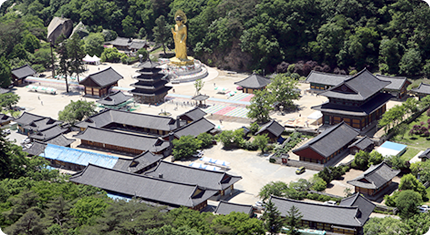 Beopjusa Temple
Beopjusa Temple
-
Beopjusa Temple, situated on Songnisan Mountain in Boeun-gun, Chungcheongbuk-do Province, is the main temple of the fifth diocese of the Jogye Order of Korean Buddhism.
According to Dongguk-yeoji-seungnam (Survey of the Geography of Korea), Beopjusa Temple was founded in 553 (14th year of King Jinheung’s reign) by Spiritual Patriarch Uisin. It’s been said that the name of the temple, Beopjusa, was given because Spiritual Patriarch Uisin went to India on a quest of the Buddha-Dharma and stay here after returning on a white donkey carrying with him the Buddhist scriptures. Accordingly, Beopjusa means a “temple where the Buddha Dharma stays.” This story is also recorded in Sinjeung-dongguk-yeoji-seungnam and Joseon-byulgyo-tongsa. Based on other records, it was also called Gilsangsa and Songnisa.
-
- Songnisan Mountain, where the temple is located, was considered one of the 8 most scenic sites of Joseon not only because of the beautiful landscape of the mountain but also because it was home to Beopjusa Temple.
Seongnisan Mountain, which was originally called Gubongsan, came to be called Songnisan in association with Beopjusa. According to Gwandongpungakbaryeonsuseokgi of Samguk-yusa (Legends and History of Korea's Three Kingdoms), in 766, Precepts Master Jinpyo met someone riding an ox card, while he was traveling from Geumsansa Temple to Songnisan Mountain, based on a divine revelation received from Maitreya Bodhisattva. After seeing the oxen crying in front of Precepts Master Jinpyo, the person on the ox cart gained faith and entered into the mountains to become a monk. For this reason, the mountain was given the name, Songnisan, which literally means a “mountain separate from the secular world.”
-
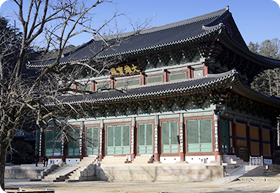 Daeungbojeon Hall of Beopjusa Temple
Daeungbojeon Hall of Beopjusa Temple
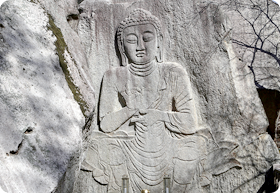 Rock-carved Buddha at Beopjusa Temple
Rock-carved Buddha at Beopjusa Temple
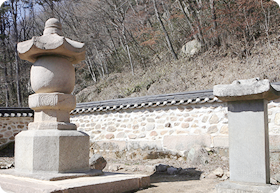 World-Honored One Sarira Stupa at Beopjusa Temple
World-Honored One Sarira Stupa at Beopjusa Temple
-
- According to the historical results, Precepts Master Jinpyo later returned to Songnisan Mountain and marked an area where auspicious plants grew. Then, he immediately went to Geumgangsan Mountain, where he founded Baryeonsusa Temple, where he stayed for 7 years. Then, while staying at Busauibang in Buan, Yeongsim, Yungjong, Bulta and others living on Songnisan Mountain came to the Precepts Master to receive the Dharma. Precepts Master Jinpyo said to them, “I’ve marked the area where auspicious plants grew on Songnisan Mountain. Build a temple there to save the world according to the doctrines and the Dharma and disseminate them among the future generations.” Obeying the master, the group went to Songnisan Mountain and found the area marked by the master. There, they built a temple, named it Gilsangsa, and held their first Jeomchal Assembly there. It is believed that Gilsangsa Temple was the precursor to Beopjusa. Considering that the temple was referred to as Songnisa in Dongmunseon (Anthology of Eastern Literature) written in 1478, it is believed that the temple was first called Gilsangsa, then Songnisa and then Beopjusa.
-
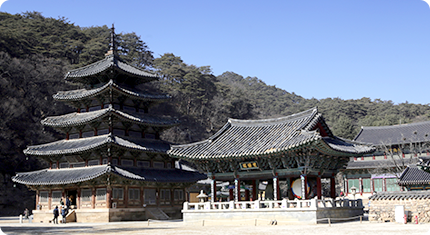 Palsangjeon of Beopjusa Temple
Palsangjeon of Beopjusa Temple
- Beopjusa Temple, home to the colossal gilt-bronze statue of the Maitreya Buddha and Maitreya beliefs, has been designated Historic Site No. 503. The area around Beopjusa Temple of Songnisan Mountain has also been designated as Scenic Site No. 61. There are 12 hermitages on the mountain including Bokcheonam, Dongam, Jungsajaam, Sanggoam, Talgoram, Sujeongam, Yeojeogam, Gwaneumam, Sanghwanam, Bonggogam, Beopgiam and Boeun Missionary Center.
